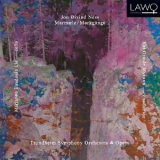Zwei bildhaft gebundene Werke, die aber nicht den Schritt zur Programmmusik gegangen sind, ergeben diese Einspielung. Marmaele mit der Stimme des solistischen Cellos ist eine Figur, die halb Meerestier, halb Mensch ist und die ihre Stimme in für normale Menschen durchaus auch mal unverständlicher Weise erhebt. Mørkgånga, also dunkler Gang, ist eine enge Felsschlucht im Umfeld von Oslo, die gern von Wanderern besucht wird.
Ness, 1968 geborener Norweger, nutzt eine bi- und polytonal geprägte Tonsprache und entwickelt diese strukturell oder auch nur farbig mit Vierteltönen. Er nähert sich der Mikrotonalität, auch traditionelle arabische Musik einbeziehend, aus verschiedenen Blickwinkeln, etwa spektral und melodisch.
Beide großformatigen Werke zeigen einen bildhaft klangmalerisch orientierten Komponisten, der es trotz des Einsatzes moderner Kompositionsmittel versteht, unmittelbar zugänglich zu formulieren und so Stimmungen zu evozieren. Gerade die oft dunkel temperierte Solostimme des Cellos in Marmaele und die ebenfalls drohend gewaltige Kulisse in Mørkgånga, die die Enge der Klamm in Tönen malt, ziehen den Hörer in ihren Bann.
Marianne Baudouin Lie ist eine fest in Norwegen verankerte und dort vielschichtig aktive Cellistin. Ihr gelingt es mühelos, ihr Solo auch durchaus schalkhaft, wie es dem Fabelwesen attestiert wird, klingen zu lassen. Dass man dabei ihr Cellospiel leichter aufnimmt als den als schwer verständlich beschriebenen Humor des Wesens spricht für ihre Beherrschung des Instruments.
Das Orchester aus Trondheim findet unter dem Dirigat von Kai Grinde Myrann überzeugend die Mischung aus farblicher Illustration der Themenwelten der Werke wie auch handwerklich exquisiter Zeichnung der herausfordernden kompositorischen Texturen. Dabei mag geholfen haben, dass Ness schon einmal Komponist des Jahres beim Orchester war und insoweit eine enge Bindung besteht. Wird auch die Musik situationsbedingt bedrohlich aufgebaut, so bleibt das Orchester einem gut strukturierten und durchhörbaren Ensembleausdruck treu.
This release comprises two pictorial works, which however have not taken the step to program music. Marmaele, with the voice of the solo cello, is a figure that is half sea creature, half human, and that raises its voice in ways that are sometimes quite incomprehensible to normal people. Mørkgånga, meaning dark passage, is a narrow rocky gorge in the surroundings of Oslo, which is often visited by hikers.
Ness, a Norwegian born in 1968, uses a bi- and polytonal tonal language and develops it structurally or just colorfully with quarter tones. He approaches microtonality, also incorporating traditional Arabic music, from different angles, such as spectral and melodic.
Both large-scale works reveal a composer with a pictorial, sound-painting orientation who, despite the use of modern compositional devices, understands how to formulate immediately accessible and thus evoke moods. Especially the often darkly tempered solo voice of the cello in Marmaele, which resembles more a Harold in Italy than the over-flying capricious soloist, and the likewise threateningly powerful backdrop in Mørkgånga, which paints the narrowness of the gorge in tones, cast a spell on the listener.
Marianne Baudouin Lie is a cellist firmly anchored in Norway and active there in many ways. She succeeds effortlessly in making her solo sound mischievous, as the mythical creature is said to be. The fact that her cello playing is easier to take in than the humor of the creature, which is described as difficult to understand, speaks for her mastery of the instrument.
The Trondheim orchestra, under the baton of Kai Grinde Myrann, convincingly finds the mix of colorful illustration of the works’ thematic worlds as well as exquisitely crafted drawing of the challenging compositional textures. It may have helped that Ness has already been the orchestra’s composer of the year, and in this respect there is a close bond. Even if the music builds up threateningly depending on the situation, the orchestra remains faithful to a well-structured and audible ensemble expression.






















